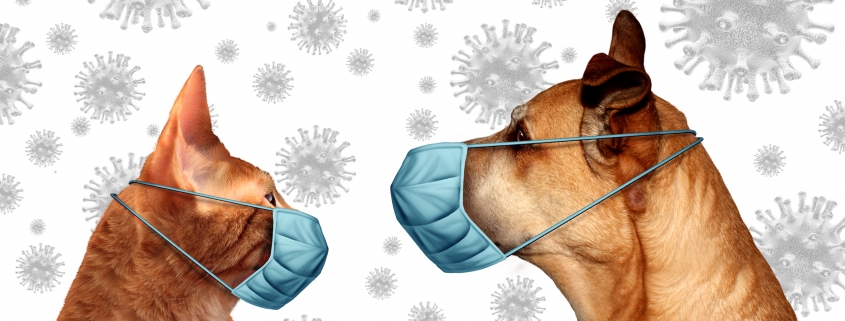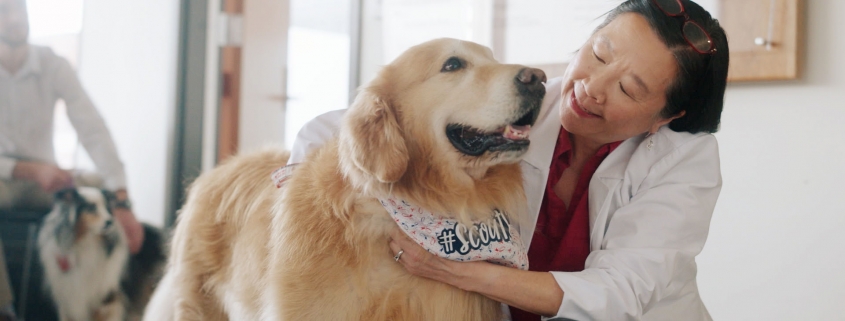BY MEGAN TREMELLING, DVM, LVS
Acute hemorrhagic diarrhea syndrome is a combination of vomiting and bloody diarrhea that can seem to come on in a matter of minutes. The resulting fluid shifts rapidly cause dehydration. The most serious cases can be fatal. Fortunately, most dogs do very well with hospitalization and appropriate care.
Brachycephalic obstructive airway syndrome (BOAS) is a polite way of saying “Bulldogs can’t breathe.” Brachycephalic dogs are the ones that are bred to have extremely short muzzles and flat faces like Pugs and Bulldogs. They frequently come with a set of anomalies including narrow nostrils; soft palates that are long enough to choke on and larynxes that are under so much pressure that they collapse. Lots of brachycephalic dogs have surgery to open up their airways so that they can breathe more easily. Do you own and love a smushy-faced dog? Ask your veterinarian whether BOAS surgery would improve your pet’s quality of life. See also Heat Stroke.
Cranial cruciate ligament (CCL) rupture is an extremely common injury that destabilizes a dog’s knee. In most cases, the ligament has worn out as much as it has been torn. Some dogs manage to hobble around on a CCL injury, but arthritis is almost inevitable. Just to make matters worse, it is quite common for dogs to rupture the ligament in both knees. Luckily, a surgical repair can restore function and reduce the development of arthritis.
Dystocia is difficulty giving birth. While many bitches whelp their puppies without drama, there are others who cannot get the job done on their own. Causes include calcium deficiency, malpositioned fetuses and several other problems, but the most common cause is that the bitch has been purposefully bred to have a tiny body. This causes difficulty accommodating the passage of a puppy especially in breeds with disproportionately big heads. A C-section then becomes a necessity.
Endocrine disease is a whole group of diseases and disorders including diabetes, hypothyroidism and Cushing’s disease. A dog’s endocrine system, like a human’s, uses chemical messengers to coordinate body functions. When the system breaks down, the results can be catastrophic. Many endocrine diseases can be diagnosed with bloodwork, and many can be successfully managed though most cannot be cured. Is your dog suddenly drinking and urinating far more than usual? Ask your veterinarian to make sure the endocrine system is on point.
Fleas are tiny, wingless insects that spend most of their lives hiding in an animal’s haircoat feeding on blood. Fleas are tough little critters. They have survived for 60 million years. They transmit diseases and parasites, trigger allergies, make animals miserably itchy and in some cases literally bleed them to death. Fleas are not the least bit impressed by old-fashioned flea collars or home remedies like cedar oil, garlic and brewer’s yeast. It is difficult to even squish them because they have such hard exoskeletons. Sometimes you can’t even see them hiding in your dog’s coat. If you do see fleas, or if your dog seems itchy for any reason, job one is ensuring that fleas are under control. Ask your veterinarian which modern flea control product is best for your pet.
Gastric Dilatation and Volvulus (GDV) is sometimes called “the mother of all emergencies.” For reasons that are not always clear, a dog’s stomach sometimes fills with gas and twists on its axis, not only preventing the vomiting that would relieve the pressure but also preventing normal blood flow. It is most common in large, narrow-chested dogs like Great Danes and Standard Poodles. Classic signs of GDV include tense, painful abdominal swelling and unproductive retching that sounds like the dog is trying to vomit but can’t. Unfortunately, it isn’t always that easy to see. If you suspect GDV, the dog should be assessed by a veterinarian immediately. Minutes count!
Heat stroke can occur whenever a dog can’t pant enough to cool themselves down. This may be when the weather is hot or humid, when the dog is exercising, when the dog has some kind of respiratory problem or—the worst—any combination of the above. Dogs are not as good at cooling themselves as humans are, and they are not at all good about knowing their limits. If you think your dog may have become overheated, wet down their coat, get in the car to the emergency clinic and turn the air conditioning on full blast!
Intervertebral disk disease or IVDD occurs when the cartilage pads that separate the bones of the spine become worn out, swollen or slip out of place. The main reason this is a problem is that the spinal cord and nerve roots can be pinched or crushed, causing anything from pain to paralysis. Dachshunds are the poster children for this disorder, but any dog can get it.
Jaundice technically is not a disease, but a symptom and is known also by the professional term “icterus.” It refers to the yellow color that develops in animals whose bilirubin level is too high. You can see it in the whites of their eyes, in their gums and anywhere the skin is bare and thin. There are two main causes: liver disease and red blood cell destruction. If your dog is looking sallow, it needs to be seen by a veterinarian right away.
Kennel cough is a catch-all term for acute infectious respiratory disease in dogs and commonly consists of laryngitis, tracheitis and bronchitis. It may be caused by any one, or a combination, of viruses and bacteria such as canine parainfluenza virus, canine adenoviruses types 1 and 2, canine herpesvirus and Bordetella bronchiseptica. Affected dogs usually have a harsh cough. Particularly in puppies, more severe illness sometimes occurs. Treatment depends on the details of each case.
Laryngeal paralysis occurs mostly in older dogs. What it means is that the vocal folds which are supposed to open wide with every inward breath don’t do so any more. You might notice that your dog’s bark is harsher or softer. You might notice a wheezing, snoring sound when he exercises. Sometimes owners notice nothing at all until the dog gets overheated or excited and tries to pant to cool down. The harder the dog tries to pant, the more the vocal folds get in his way. This is a life-threatening emergency that requires immediate veterinary attention. Luckily, a surgical procedure can improve the situation. See also Heat Stroke.
Mitral valve disease is probably the most common form of heart disease seen in dogs. It usually happens when, over time, one of the valves in the heart starts to get a bit leaky. Many, many dogs, especially small ones, develop a heart murmur in their senior years as a result of mitral valve disease. For some of them, but not all, it becomes a life-threatening problem. If your dog has a new heart murmur or a chronic cough, ask your veterinarian whether a chest x-ray is warranted.
Neoplasia, better known as cancer, is not one disease but a whole category of diseases characterized by uncontrolled cell growth. It is the main cause of death in well-cared-for older dogs, partly because most types can’t be prevented and because it usually doesn’t respond as well to treatment as some other diseases. Exceptions do exist, though, and veterinary oncologists (cancer specialists) work every day to help canine cancer patients live the longest, happiest lives possible.
Osteoarthritis is, unfortunately, extremely common in older dogs, especially large ones. Your veterinarian may call it DJD or degenerative joint disease. You might notice that your pet is stiff and slow to get up after a nap, especially after hard exercise but seems better after they move around a bit. Osteoarthritis cannot be reversed, but your veterinarian can help your dog to stay functional and pain-free as long as possible.
Pyometra is an infection of the uterus. In dogs, it has an unfortunate tendency to turn into a catastrophe very quickly, so by the time an owner realizes the dog is sick, her life is in danger and she needs emergency surgery. Pyometra is unfortunately very common, so all owners of unspayed females need to be on the lookout for the slightest signs of illness, and be prepared to deal with the emergency. In most cases, the best prevention is a routine spay.
Quadriceps contracture can happen as a complication of a fracture of the femur (thighbone). The quadriceps femoris is a group of muscles that extends the stifle (knee) joint, so it is necessary for normal standing and walking. When the thigh is injured, sometimes the quadriceps heals by turning into rigid scar tissue, resulting in a stifle that cannot flex and a leg that cannot be used. Contracture can occur in any circumstance, but it is more common when the fracture is not treated properly. Surgical repair of the fracture not only allows the bone to heal correctly but also allows for critical rehabilitation exercises that keep the joints flexible and the muscles moving.
Rabies remains a serious health concern for dogs and for humans, even though a robust canine vaccination program can protect both populations. In countries where canine vaccinations are prohibitively expensive, rabies kills dogs and humans, horribly and indiscriminately. Fortunately, rabies vaccinations are within the means of most dog owners in the United States, to say nothing of being required by law.
Seizures, or convulsions, can occur in dogs from a variety of causes. The most common cause is epilepsy which in dogs is partly genetic in origin and manifests in young adult dogs, ranging from brief focal seizures to longer, full-body convulsions. Other causes include brain diseases, poisons and metabolic disorders. Unless your dog has a known and well-managed seizure disorder, any kind of seizure activity should warrant prompt veterinary attention.
Tracheal collapse is just what it sounds like. The trachea, or windpipe, is supposed to be round like a pipe for good airflow, but if it becomes soft, it can collapse on itself making it hard for the dog to breathe. And, just like a straw when you suck on it too hard, the harder you try to move air, the more stubbornly it stays collapsed. Unfortunately, tracheal collapse is very common in small dogs and in brachycephalic breeds. If your dog tends to cough or wheeze when he gets excited, ask your veterinarian to take an x-ray to look for signs of collapsing trachea. You can’t make it go away, but there are strategies to reduce its effect on the dog. See also Heat stroke.
Urinary tract disease in dogs often appears as blood in the urine, straining to urinate or marked increase in frequency of urination. The causes may include bacterial infections, bladder stones, anatomic anomalies or any combination of the above. It’s tempting to just ask your veterinarian for an antibiotic, but tests will be needed to pin down a diagnosis and keep problems from progressing.
Vestibular disease refers to any problem that affects the vestibular system meaning that part of the brain and inner ear that controls balance. When humans experience vestibular disease, we often describe it as vertigo. Dogs can develop vestibular disease from serious problems like tumors or strokes but also from ear infections and a benign problem called Idiopathic Vestibular Disease. Owners often assume that a dog that is suddenly too dizzy to stand up has suffered a serious stroke and must be euthanized, but this is not always the case.
Worms are internal parasites that find a way into your pet’s intestines, lungs or, worst of all, heart and blood vessels. Most can be identified through blood or fecal testing, and most can be treated. However, many worm infestations go unnoticed meaning that pets who appear healthy can go around shedding microsopic worms and eggs to infect other hapless dogs… and, sometimes, their humans too! Do your neighbors a solid and ask your veterinarian to review your pet’s worm control plan, especially if you and your pet are regular dog park visitors.
Xylitol toxicity is just an example of the environmental hazards that can poison your pet. Xylitol is an artificial sweetener that is apparently harmless to humans but can cause serious harm to dogs including seizures and liver damage. No sugar-free gum for Max and Bella, please!
Yeast infections in dogs most commonly occur in the ears and skin. Usually the yeast is the kind that lives in small numbers on all dogs’ skin, but in some dogs, at some times, the population grows like gremlins in a rainstorm. There is often an underlying problem such as an allergy. Your veterinarian can identify a yeast infection and provide the proper treatment to relieve your dog of this itchy, stinky misery.
Zoonotic disease is defined by medical doctors as a disease of humans that is transmitted to them by animals. Veterinarians, however, define it as a disease that can be transmitted from animals to humans or vice versa. Unfortunately, we can be as much of an infection hazard to animals as they can be to us. For example, some influenza viruses can hop species, and while we know that some types of avian and swine influenza can cause serious illness in humans, we should also be aware that some animal species, like cats and ferrets, can catch some forms of influenza from us. Luckily for our pets, it is uncommon for humans to transmit serious infections to animals.








